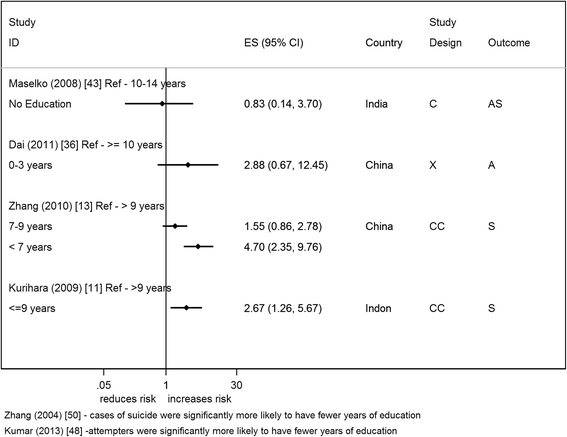Association of socio-economic position and suicide/attempted suicide in low and middle income countries in South and South-East Asia - a systematic review
- PMID: 26472204
- PMCID: PMC4608117
- DOI: 10.1186/s12889-015-2301-5
Association of socio-economic position and suicide/attempted suicide in low and middle income countries in South and South-East Asia - a systematic review
Abstract
Background: Forty percent of the world's suicide deaths occur in low and middle income countries (LAMIC) in Asia. There is a recognition that social factors, such as socioeconomic position (SEP), play an important role in determining suicidal risk in high income countries, but less is known about the association in LAMIC.
Methods: The objective of this systematic review was to synthesise existing evidence of the association between SEP and attempted suicide/suicide risk in LAMIC countries in South and South East Asia. Web of Science, MEDLINE, MEDLINE in Process, EMBASE, PsycINFO, and article reference lists/forward citations were searched for eligible studies. Epidemiological studies reporting on the association of individual SEP with suicide and attempted suicide were included. Study quality was assessed using an adapted rating tool and a narrative synthesis was conducted.
Results: Thirty-one studies from nine countries were identified; 31 different measures of SEP were reported, with education being the most frequently recorded. Most studies suggest that lower levels of SEP are associated with an increased risk of suicide/attempted suicide, though findings are not always consistent between and within countries. Over half of the studies included in this review were of moderate/low quality. The SEP risk factors with the most consistent association across studies were asset based measures (e.g. composite measures); education; measures of financial difficulty and subjective measures of financial circumstance. Several studies show a greater than threefold increased risk in lower SEP groups with the largest and most consistent association with subjective measures of financial circumstance.
Conclusion: The current evidence suggests that lower SEP increases the likelihood of suicide/attempted suicide in LAMIC in South and South East Asia. However, the findings are severely limited by study quality; larger better quality studies are therefore needed.
Systematic review registration: PROSPERO 2014: CRD42014006521.
Figures











Similar articles
-
Housing improvements for health and associated socio-economic outcomes.Cochrane Database Syst Rev. 2013 Feb 28;(2):CD008657. doi: 10.1002/14651858.CD008657.pub2. Cochrane Database Syst Rev. 2013. PMID: 23450585
-
Drugs for preventing postoperative nausea and vomiting in adults after general anaesthesia: a network meta-analysis.Cochrane Database Syst Rev. 2020 Oct 19;10(10):CD012859. doi: 10.1002/14651858.CD012859.pub2. Cochrane Database Syst Rev. 2020. PMID: 33075160 Free PMC article.
-
Prevention of self-harm and suicide in young people up to the age of 25 in education settings.Cochrane Database Syst Rev. 2024 Dec 20;12(12):CD013844. doi: 10.1002/14651858.CD013844.pub2. Cochrane Database Syst Rev. 2024. PMID: 39704320
-
Slum upgrading strategies involving physical environment and infrastructure interventions and their effects on health and socio-economic outcomes.Cochrane Database Syst Rev. 2013 Jan 31;2013(1):CD010067. doi: 10.1002/14651858.CD010067.pub2. Cochrane Database Syst Rev. 2013. PMID: 23440845 Free PMC article.
-
A rapid and systematic review of the clinical effectiveness and cost-effectiveness of paclitaxel, docetaxel, gemcitabine and vinorelbine in non-small-cell lung cancer.Health Technol Assess. 2001;5(32):1-195. doi: 10.3310/hta5320. Health Technol Assess. 2001. PMID: 12065068
Cited by
-
Psychiatric morbidity and suicidal behaviour in low- and middle-income countries: A systematic review and meta-analysis.PLoS Med. 2019 Oct 9;16(10):e1002905. doi: 10.1371/journal.pmed.1002905. eCollection 2019 Oct. PLoS Med. 2019. PMID: 31597983 Free PMC article.
-
Sociodemographic Antecedent Validators of Suicidal Behavior: A Review of Recent Literature.Curr Psychiatry Rep. 2016 Oct;18(10):94. doi: 10.1007/s11920-016-0732-z. Curr Psychiatry Rep. 2016. PMID: 27595860 Review.
-
Is socioeconomic position associated with risk of attempted suicide in rural Sri Lanka? A cross-sectional study of 165 000 individuals.BMJ Open. 2017 Mar 22;7(3):e014006. doi: 10.1136/bmjopen-2016-014006. BMJ Open. 2017. PMID: 28336743 Free PMC article. Clinical Trial.
-
Patterns of childhood trauma co-occurrence and its predictivity for suicidality: A machine learning approach.iScience. 2025 Jan 28;28(2):111877. doi: 10.1016/j.isci.2025.111877. eCollection 2025 Feb 21. iScience. 2025. PMID: 40041770 Free PMC article.
-
The Role of Unemployment, Financial Hardship, and Economic Recession on Suicidal Behaviors and Interventions to Mitigate Their Impact: A Review.Front Public Health. 2022 Jul 6;10:907052. doi: 10.3389/fpubh.2022.907052. eCollection 2022. Front Public Health. 2022. PMID: 35875017 Free PMC article. Review.
References
-
- WHO . Preventing suicide - A global imperative. Geneva: WHO; 2014.
-
- Stack S. Suicide: a 15-year review of the sociological literature. Part I: cultural and economic factors. Suicide Life Threat Behav. 2000;30(2):145–162. - PubMed
Publication types
MeSH terms
Associated data
Grants and funding
LinkOut - more resources
Full Text Sources
Other Literature Sources
Medical

